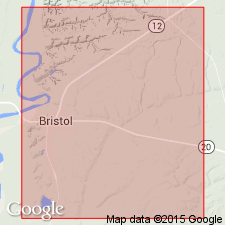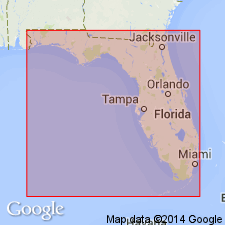
- Usage in publication:
-
- Bristol formation
- Modifications:
-
- Original reference
- AAPG geologic province:
-
- South Georgia sedimentary province
Summary:
Pg. 51. Bristol formation. If Altamaha is restricted as a formation name, restricted if necessary to the deposits consisting chiefly of red sands and clays lying above the Miocene, it is very possible that the similar materials of this area between Apalachicola and Ocklocknee Rivers may be included in that formation. If not referable to Altamaha formation, possibly these materials may be referred to Citronelle formation, although this should not be done until fossils can be obtained or continuity of deposition with Citronelle formation can be determined. If these materials can be referred to neither of these formations, they may be known as Bristol formation, from their typical exposure in vicinity of Bristol, [Bristol 7.5-min quadrangle, Liberty County, northern Florida], where they are known to lie stratigraphically above the Choctawhatchee Miocene. [Age is Pliocene.]
Source: US geologic names lexicon (USGS Bull. 896, p. 268).

- Usage in publication:
-
- Bristol formation†
- Modifications:
-
- Abandoned
- AAPG geologic province:
-
- South Georgia sedimentary province
Summary:
Mapped these deposits as Citronelle formation, and abandoned the preoccupied name "Bristol."
Source: US geologic names lexicon (USGS Bull. 896, p. 268).
For more information, please contact Nancy Stamm, Geologic Names Committee Secretary.
Asterisk (*) indicates published by U.S. Geological Survey authors.
"No current usage" (†) implies that a name has been abandoned or has fallen into disuse. Former usage and, if known, replacement name given in parentheses ( ).
Slash (/) indicates name conflicts with nomenclatural guidelines (CSN, 1933; ACSN, 1961, 1970; NACSN, 1983, 2005, 2021). May be explained within brackets ([ ]).

